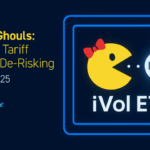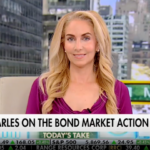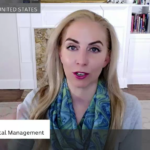
IVOL: Charting Shaky Markets
The Quadratic Interest Rate Volatility and Inflation Hedge ETF's (Ticker: IVOL) NAV is up +13.46% YTD, whereas the Bloomberg TIPS index is up 2.36% YTD as of April 21st.1
What has been happening in 2025 is not a tail event. It is just the start of the normalization of the interest rate markets. Note that the curve on which IVOL owns options is currently at +21bps in the spot market, after remaining inverted for about 3 years. Since the swaps market started in the late 1980s, the average spread has been around 100bps, with a high of 299bps. So, despite the recent moves, the curve still has plenty of room to return to normal.
IVOL offers its investors additional spread beyond Treasuries, but that spread is on interest rates, not corporate credit. Many of our investors use IVOL as a spread and return product rather than loading up on additional corporate credit risk, as most have plenty of corporate risk from their stock portfolios already. Whether you own a company’s stock or its bonds, you are exposed to a lot of the same risks. You’re betting on the company’s management, its products, its sector, and the broader market beta. The stocks and bonds of a corporation tend to have similar directional performance: credit spreads widen when equities fall, so the stock and the bonds tend to move together. Corporate credit risk is a carry trade, and it does not take much spread widening to eliminate a full year’s worth of carry.
Investors seeking carry but concerned about the current asymmetry in credit spreads and other fixed income markets may want to consider that IVOL has paid a steady distribution of at least 30 bps every month for over 5 years in a row.2
IVOL is primarily invested in TIPS. TIPS prices are sensitive to real growth. Markets are getting more cautious about a potential economic slowdown caused by higher rates and tariffs. For example, in March 2025 Goldman increased its 12-month recession probability to 35% from 20%, pointing to "soft data" such as a sharp deterioration in household and business confidence and a slowing in real economic growth. If we indeed get lower growth in 2025-26, one could expect real yields to move lower and help TIPS investments. But IVOL gives investors exposure to TIPS plus inflation expectations outside of CPI, which could potentially remain elevated as a result of less immigration and more tariffs. IVOL combines TIPS with long, fully funded OTC rates options. IVOL is designed to solve the problems inherent with TIPS alone:
- The first problem is the only index of inflation used by TIPS is the Consumer Price Index (CPI). CPI is a widely criticized measure calculated by the Bureau of Labor Statistics (BLS). Roughly 1/3 of the entire index is rent. Even the Fed does not use CPI as its primary gauge for inflation. IVOL provides investors another way potentially to profit from inflation that isn’t captured by the CPI index. IVOL adds market-based inflation expectations outside of CPI alone.
- The second problem with TIPS alone is all TIPS are long duration. Even short duration TIPS are still long duration. They are just less long duration and more of a bet on realized CPI announced by the BLS. IVOL addresses this issue through its positive convexity, which seeks to profit from rising long term yields.
- Since IVOL is long options, it also provides a way to profit from increased volatility as the fund is long interest rate volatility. IVOL’s options have the potential to profit if the yield curve steepens from the expectation that the Fed will cut policy rates more than expected. Despite all the uncertainty around geopolitics and tariffs, interest rate volatility remains subdued. For example, 1y2y swaption volatility is down about -31% since the March 2023 peak. And IVOL’s type of implied rate volatility is trading about ~50% cheaper than the MOVE index. By owning shares in IVOL, investors are long interest rate volatility at these levels that are ½ of where the MOVE index is trading as of April 21st.
Our long interest rate options offer exposure to the shape of the yield curve. The shape of the yield curve is defined as the difference between long-term and short-term rates. Normally longer-term rates are higher than short-term rates. Think about it as if you were making a loan. If you lend money for longer, would you expect to be paid more or less?
There is a risk that we get both inflation and recession: stagflation. We believe that IVOL could be helpful in the current environment, especially for stagflation risk mitigation. Please access our white paper explaining how IVOL can potentially help if you are concerned about rising risks for Stagflation here.
Looking at all the uncertainty in the marketplace, investors seem to be moving away from both equity and bonds. Gold has recently been a beneficiary of this environment. But while it has been a good investment, some see it as expensive now. Gold also has longer term issues in an environment of relatively high real yields: gold doesn’t pay dividends, and the owner directly or indirectly needs to pay for storage. Furthermore, the US holds more than 8,000 metric tons of gold, valued at $42 per ounce.3 If this gold position is marked at current market prices, there could be discussions to sell a portion of it to reduce the government debt or investing in infrastructure. Even discussions could be a catalyst to push the price lower.
Investors could complement their gold exposure with IVOL, as both could serve as an inflation hedge and a source of distributions. Remember - IVOL has distributed at least 30bps monthly since the summer of 2019. IVOL could potentially work as a risk-off diversifier. It can also potentially benefit if volatility increases since IVOL is long interest rate volatility though its options. Additionally, as markets get more worried about the US fiscal situation, long dated yields could rise, also causing the yield curve to steepen.
For financial professionals interested in learning more about IVOL we have a full white paper that describes the strategy here.
Citations:
- Data from Bloomberg as of 4/21/25
- The fund started paying distributions in July 2019 of at least 30bps a month through December 2024. For IVOL’s standard performance and 30 day SEC yield as of the most recent calendar quarter, please click here. Distributions may contain a return of capital.
- https://www.forbes.com/sites/greatspeculations/2025/02/24/is-it-time-for-the-us-to-revalue-its-gold-reserves/
Index Definitions:
Bloomberg U.S. Treasury Inflation-Protected Securities (TIPS) Index - measures the performance of U.S. Treasury Inflation-Protected Securities. These are government-issued bonds designed to protect investors from inflation by adjusting the principal value based on changes in the Consumer Price Index (CPI). The index includes all publicly issued TIPS that have at least one year remaining to maturity and are rated investment grade. It serves as a benchmark for investors seeking inflation-linked fixed income exposure.
The MOVE Index—short for Merrill Option Volatility Estimate—is a measure of volatility in the U.S. bond market, specifically U.S. Treasury bonds. It's often referred to as the "bond market's VIX," with the VIX being a similar index for equities.
Term Definitions:
Consumer Price Index (CPI) – A key economic indicator that measures the average change in prices paid by consumers for goods and services over time. It is widely used to assess inflation.
Interest Rate Curve (Yield Curve) – A graphical representation of interest rates (yields) on bonds of different maturities. The shape of the curve (normal, flat, or inverted) provides insights into economic conditions and monetary policy expectations.
Interest Rate Volatility – A measure of the fluctuation in interest rates over time. High volatility can indicate uncertainty in monetary policy, economic conditions, or credit markets.
Long Duration – A fixed-income strategy that involves investing in bonds with longer maturities. These securities are more sensitive to interest rate changes and typically provide higher yields than shorter-duration bonds.
Real Yields – Bond yields adjusted for inflation, providing a true measure of an investor’s return after accounting for changes in purchasing power.
Swaps – Financial derivatives where two parties exchange cash flows, typically involving a fixed interest rate exchanged for a floating rate. Commonly used for hedging or speculation.
2y10y SOFR curve – refers to the difference (or spread) between the 10-year and 2-year swap rates derived from the Secured Overnight Financing Rate (SOFR) interest rate swap curve. This spread is a key measure of the shape of the SOFR swap curve between the 2-year and 10-year maturities and is
TIPS (Treasury Inflation-Protected Securities) – U.S. government bonds designed to protect investors from inflation. The principal value adjusts with changes in the CPI, ensuring purchasing power is maintained.














